Treating Cancer with Cannabis Oil: The Story of 13-year-old Chico Ryder
I am including the very novel and interesting case of Chico Ryder for several unique reasons. One is that this is an extremely rare type of cancer that is not easily cured. Secondly, for the first time that I am aware, we are given the actual cannabis protocol in a more scientific way courtesy of Aunt Zelda’s. They provided us with a precision dosing, and a quantitative measure of, the several marijuana preparations they currently employ. This to me is a first.
Usually, we see families report that their son or daughter was given RSO (Rick Simpson Oil; essential oil of cannabis) in the standard dosages we are accustomed to. That’s typically one gram per day for three months. That it’s usually an Indica strain to allow for sedation and sleep as curatives. But that’s just about it as far as the essential oil dosing goes. Because of this lack of precision, and several other problems that we encounter with anecdotal case reports, we often have more questions than answers.
So it’s reassuring to see that finally caretakers are cognizant of being more scientific in their dosing approach. In a very real sense, we are all stumbling around in the dark since the world is still hamstrung on organizing phase II or III clinical trials, or for that matter any human trials. We need to be precise if we are ever going to be able to measure cannabis’s ability to treat diseases, and to use this information to launch clinical trials. Some of the information may be very useful to physicians based on these anecdotal case reports.
Remember too that anecdotal reports, as unscientific as they are, and typically frowned upon by mainstream oncologists, can lead to serious scientific inquiry. That’s the good news. We just need to put them into meaningful and well organized case files.
FIRST TO USE BOTH HIGH THC AND HIGH CBD TOGETHER
The other interesting thing about this case is they provide a laboratory analysis of all cannabis preparations they are using. So we get a better feel for the actual quantity of, for example, the THC content.
Lastly, this case is the first time I’ve seen a high CBD strain used with a high THC strain together. I have often wondered why CBD was usually sidelined, unless they were treating a seizure disorder. But then they would sideline the THC in that case. I personally feel that we need to use an extract blend of two varietals: one rich in CBD, the other a THC dominant varietal. That’s what they did here and I’m impressed.
Sadly, this particular case does not include imaging studies which are so vital for our discussion. Nonetheless we do have a detailed account of Chico’s amazing journey. This case also emphasizes the importance of cannabis in reducing or eliminating the vicious cycles of vomiting, and pain these unfortunate children must endure daily.
Try to imagine how sick and nauseated one becomes from any number of drugs. The perception of nausea, feeling that at any moment one might vomit, is one of the worst things patients must endure. I know, my anesthesia practice involves making people nauseated. I get paid to prevent that from developing. Patients are immensely thankful as you can imagine.
But the nausea from chemo has no equal. It is absolutely debilitating; as patients count the seconds ticking on the wall clock waiting for relief. Chico Ryder experienced a nearly intractable form of nausea that was very, very difficult to address. In other words, nothing the hospital had on their formulary helped. That to me is a nightmare as anyone who has experienced severe nausea can attest to.
MEDICAL MARIJUANA CONFERENCE
At a three-day conference entitled, Marijuana for Medical Professionals 2014 in Denver, professionals from all over the world attended and presented their findings. One of the most impressive case studies was the pediatric cancer case report of Chico Ryder by Mara Gordon, the owner of Aunt Zelda’s, an MMJ dispensary with a twist. They discussed this interesting case featured below.
Chico Ryder was 10 years old when he was diagnosed with Stage III/Group III parameningeal embryonal rhabdomyosarcoma, an especially aggressive soft tissue cancer, in December 2012. From the day he was diagnosed, he was started on a particularly heavy chemotherapy and radiotherapy protocol.
RHABDOMYOSARCOMA DEFINED
Before we discuss the details of this fascinating case, let me define for you what this type of cancer is. It is very rare, and very deadly, and yes, a mouthful to pronounce!
There are two kinds of muscle cells in the body: smooth muscle cells and skeletal muscle cells. Smooth muscles control involuntary activities; skeletal muscles control voluntary activities. (Actually there’s cardiac muscle too, a mix of the two above mentioned types.)
Rhabdomyosarcoma (RMS) is a malignant tumor (“cancer”) that arises from a normal skeletal muscle cell. Not very much is known about why normal skeletal muscle cells become cancerous.
Because skeletal muscle cells are found in virtually every site of the body, RMS can develop in almost any part of the body.
RARE AS HEN’S TEETH
RMS is a very rare cancer. There are only about 350 cases of RMS diagnosed each year in the United States in children under the age of 21 years.
About four children per million healthy kids under the age of 15 will develop RMS each year. It is slightly more common in boys than in girls and it is most common in young children under the age of five.
Rhabdomyosarcoma is very uncommon in adults. There have been five “large” published series, totaling just over 400 cases of “adult” RMS (including some “children”) seen at major cancer centers in the United States and Europe over the past 20-30 years.
Treatment principles for managing adults with RMS are similar to those for children, and outcome is not intrinsically worse for adults treated with modern protocols.
The most common locations for these tumors to develop are in the structures of the head and neck (nearly 40% of all cases), the male or female genitourinary tract (about 25% of all cases), and the extremities (about 20% of all cases).
Because of its preference for the head, patients initially might complain only of a stuffy nose, for example, that may last for months, or vague eye complaints that stymie physicians as to the cause.
Since about 25% of cases arise in one of the structures of the genitourinary system including the paratesticular region, the female genitourinary tract (vulva, vagina, cervix, uterus), the urinary bladder, and the prostate, symptoms can mimic dozens of less dangerous diseases and delay early diagnosis.
Approximately 20% of cases arise in an extremity like the arm of leg. The remainder of cases arise in diverse sites including the chest wall and retroperitoneum. Under those conditions the tumor can easily grow unimpeded until it’s incurable.
Therefore, there are “favorable” sites for your cancer that mean less risk of dying, should you develop one in a favored region.
FAVORABLE VS UNFAVORABLE SITES
Tumors that arise in the orbit, non-parameningeal (not alongside the meninges-the wrapping of the spine and brain) head and neck sites (for example, the cheek or the ear lobe), and the male (paratesticular) or female (vagina, vulva, cervix, or uterus) genital tracts are considered “favorable.” Favorable in this setting means a better prognosis.
All other sites are considered “unfavorable.”
RISK ASSESSMENT
Chico was diagnosed as “intermediate risk” which means:
Intermediate-risk: These patients comprise the majority of patients with newly diagnosed RMS and include those with unfavorable site tumors…that have not been completely resected…, patients under the age of ten with embryonal RMS that has spread to other parts of the body…
Although this is a diverse group of patients, the prognosis for cure with 3 (or more) drug chemotherapy and radiation therapy is usually better than 50%, and perhaps as high as 70% for certain sub-groups.
TREATMENT OPTIONS
Treatment of RMS. From www.CureSearch.org:
All children with rhabdomyosarcoma require a local control measure, which means direct treatment specifically to the site of the tumor.
- Local control can be done by surgery alone, radiation alone, or a combination of both surgery and radiation.
- The best local control option depends on the location of the tumor, how easily it can be removed with surgery, and the results of any surgery performed.
- If embryonal rhabdomyosarcoma is removed completely by surgery, and the pathologist determines the margins are clean, or negative (no cancer cells are present at the edges of the removed mass), then no further treatment measures may be necessary.
- In many other cases, combination with radiation therapy may be used to minimize the risk of tumor recurrence or relapse.
Only about 15-20% of patients will have visible spreading (metastasis) of rhabdomyosarcoma, but all patients are considered to have micrometastatic spread (too small for detection by radiologic tests). For this reason, chemotherapy should be used to treat all patients with RMS with the aim of eliminating micrometastatic tumor cells and decrease the likelihood of recurrence. Many different types of chemotherapy are used, and usually in combination. The specific combination selected depends on cell type, primary tumor location and extent of the disease.
PROGNOSIS FOR RMS
Prognosis for RMS. From Cancer.org:
Chico Ryder was diagnosed with intermediate-type RMS.
For those in the intermediate-risk group, the 5-year survival rates range from about 60% to about 80%. The rate varies based on tumor location, stage, and the age of the child (children aged 1 to 9 tend to do better than older or younger children).
THE CASE OF CHICO RYDER CONTINUED
Happy Mondays star Paul Ryder, the bass player and one of the founding members of the Manchester band, told MailOnline how he treated his 11-year-old son’s cancer with cannabis.
It was tricky because, as a recovering addict, he would never have encouraged Chico to take any addicting or recreational drugs. But when faced with his son’s diagnosis, he and his wife made the decision to try cannabis oil as a remedy for the terrible adverse drug reactions his son was having from the chemotherapy.
SORE THROAT
Chico first presented with a sore throat in November 2012. Initially they thought that he may have had a lymphoma. A biopsy ruled that out. The family thought they got lucky and dodged a bullet.
However, the lymph node swellings got worse. Just five days before Christmas 2012, he became very ill. More tests were performed and only three days after Christmas his family received the worst news of their lives: Chico has a very rare type of cancer called rhabdomyosarcoma.
Chico’s illness came as a huge shock to his parents and older brother Sonny, age 12. His mother Angela, 50, said: ‘Before he became ill, he was a normal, energetic little boy. He loved skate-boarding, dirt-biking and football.’
‘Everything was going well until we were hit with an almighty bombshell.’ His mother continued, said: ‘By this time the swelling had grown much bigger.’
‘The doctors said he only had 10 more days before it would completely block his airways.’
‘We were worried sick’.
‘We laid all his presents in his hospital room on Christmas Day, but he had no interest in them.’
‘It was so surreal to know that the rest of the world was oblivious, enjoying the festivities,…while we were stuck in a hospital, dealing with our worst nightmare.’ Paul told MailOnline: ‘I walked in there, to his hospital room and I just lost it, he looked so sick and frail. I went straight into the bathroom and threw up.’
It was the start of a battle which would see Chico cheat death more than once – while his father and uncle, Happy Mondays front man Shaun Ryder, hid their furtive anguish from fans.
Surgery was too risky, and so Chico began a 43-week course of chemotherapy, along with radiation.
CASE CONTINUED – A BRUTAL SCHEDULE
Chico Ryder started immediately on the standard protocol for this diagnosis –the VAC chemotherapy regimen (Vincristine, D-Actinomycin and Cyclophosphamide) for 43 weeks and also received 28 radiation sessions over the course of approx. 6 weeks which began approximately 6 weeks after chemotherapy started.
The VAC regimen consists of weekly infusions (with several short breaks) of Vincristine and every three weeks, infusions of D-Actinomycin and Cyclophosphamide.
The tumor responded well to the therapy and significant shrinkage had occurred by the first three-month scans.
Chico suffered with severe nausea and vomiting as well as foot drop and peripheral neuropathy, and within three months was in a wheelchair with severe mobility impairment.
His appetite was severely impacted by the chemotherapy, and eating was further compromised due to radiation treatment affecting his mouth, throat and salivary glands, resulting in drastic weight loss. He was put on TPN (IV nutrition) approximately two months into treatment.
NOTHING HELPS HIS NAUSEA
Doctors in Los Angeles (where Chico lives) somewhat familiar with THC prescribed the synthetic THC pharmaceutical called Marinol to ease the side effects of the chemotherapy, such as nausea and vomiting.
Doctors prescribed Marinol when all other pharmaceuticals had failed to halt the severe nausea and vomiting. His condition was described as one of the most severe cases they had ever witnessed in the Pediatric Oncology Department UCLA.
The Marinol seemed to help initially, but that didn’t last very long. Soon Chico was nauseated and vomiting profusely. He was not able to eat so the TPN was the only source of calories.
Desperately looking for anything that might stop the relentless vomiting they requested medical marijuana. Of course, that would be criminal in just about half the states in America. Yet, it’s probably the best drug there is for chemo induced nausea and vomiting. Luckily they were in a canna-friendly state, California. Their oncologist approved the use of MMJ for Chico on the condition that he not smoke it.
SMOKED CANNABIS NOT RISKY
I’m not certain why they added that requirement since one of their own physicians, Dr Tashkin, a world authority on marijuana and pulmonary disease, has found smoking cannabis to be surprisingly free of adverse effects. That would include no increased risks for: head and neck squamous cell carcinoma, lung cancer, and COPD. In fact, he shocked the research community with these findings. He remarked that cannabis smokers even have improved pulmonary functions tests compared to non-cannabis smokers.
Okay, so they got him to vaporize it instead.
Paul, 49, originally from Salford, told MailOnline: ‘I found myself coaching him on how to inhale cannabis vapour from a vapourising machine.’
In addition, they would run it (RSO) through his feeding tube/NG tube(?) thus making it easier to administer. Recall from above that this RSO preparation was sourced using several varietals to produce a remarkably balanced medication rich in both anti-cancer Titans, CBD and THC. Of course all of the other potent cannabinoids were there too in lesser and varying amounts.
So far, I think this type of preparation is the wave of the future. It only makes sense to use both phytocannabinoids, not just THC.
INSTANT RELIEF
Chico’s father quipped, ‘It was surreal – but it worked brilliantly, and gave him instant relief.’
‘I never in a million years imagined that I would ever be buying cannabis oil for my 11-year-old son and giving him relatively high amounts of it down his stomach tube.’
‘What isn’t quite so widely known is that cannabis also seems to have the ability to actually fight the cancer itself, as well as mitigating the side effects of the chemo.’
For Paul, the irony of giving drugs to his son was not lost.
He told MailOnline: ‘I am a recovering addict and haven’t had a drink or drug for many years, so there’s no way I would ever have encouraged my son to take cannabis. But when Angela told me what she had discovered I couldn’t really argue and had to agree that we had to get some for him.’
THANK GOODNESS WE LIVED IN CALIFORNIA
‘It was the best thing we could have done. In my opinion it’s a medicine not a drug, and thank goodness we were living in California.’
‘We built up the dose slowly as his tolerance rose. It made a big difference in his overall well-being. It definitely made the treatment more tolerable. He started to smile. It certainly didn’t solve every problem but it helped make his life more bearable through the treatment.’
REMISSION
In December last year, the family got the best news they could have hoped for – Chico was in remission.
His mother said: ‘Chico has lost his hair and needs a wheelchair from the side effects of his treatment, but we know he’ll be back on his feet soon. He still has a very cheeky sense of humour and he can’t wait to return to normal life.’
Paul and his band mates are now planning their first ever black tie ball for Chico – and hope the little boy will be well enough to fly to the UK as guest of honour.
His uncle, Shaun, said: ‘Our Chico kicked cancer, he is a real fighter.’
The case summary presented below comes from the pdf manuscript entitled Pediatric Cancer and Cannabis, Changing The Treatment Conversation. Authors Stewart Smith, Mara Gordon.
Below is Chico’s dosing schedule. I get different numbers based on their suggested dosing (E.G., strain 1, fire OG dose closer to 100 mg THC, not 150 mg. OG: 60% THC = 600 mg per 1,000 mg; ¼ g = 150 mg THC, not 0.162 g which equals 97.2 mg THC. Daily dose is less than 200 mg, a bit shy of the suggested 300 mg per day) but it’s still nice to see a more scientific effort.

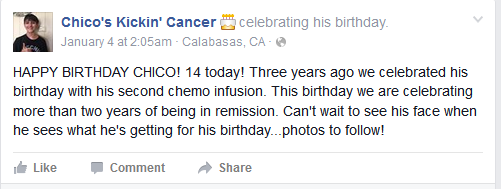
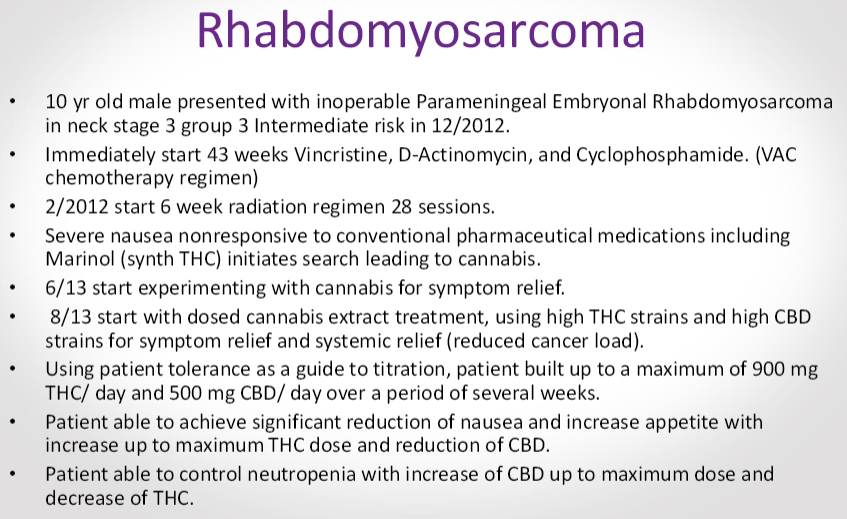
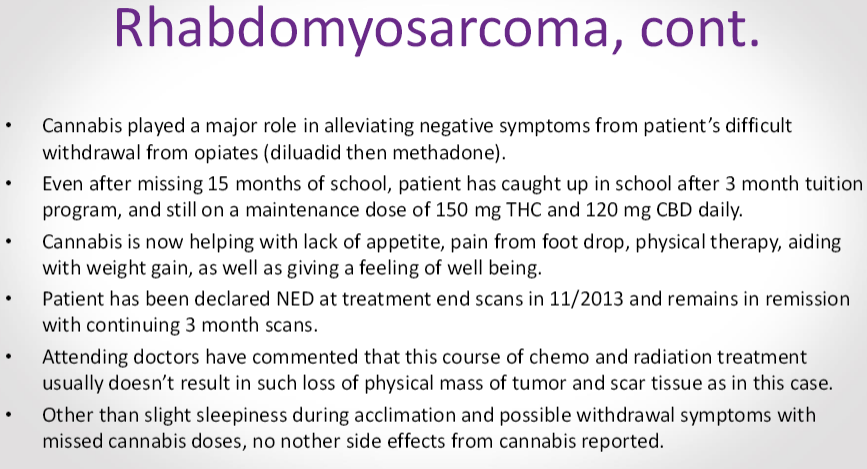
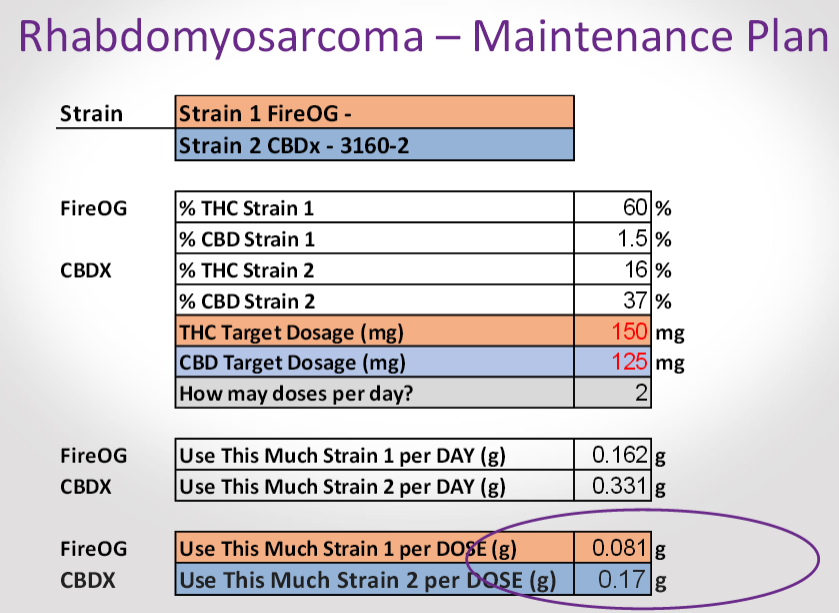
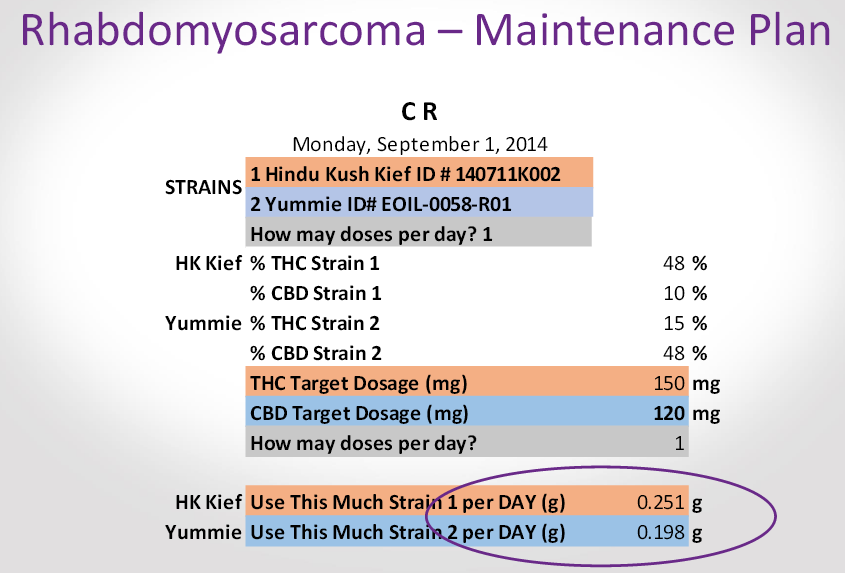
Great story. These types of case studies are not just annecdotes. They are at the heart of clinical practice and if conducted properly contribute to scientific knowledge.
Congratulations for helping a hieve this wonderful outcome.
Contact me at
pfadtag@aol.com
if you are interested in learning about a single subject research design I am conducting using medical marijuanna to treat my prostate cancer.
Dear Dr, will medical marajauna cure my adenocarcinoma in my lungs? Its supposed 2 b stage 1 but it has com bak after first surgery into other lung. They belived it was a new cancer site not a spread. (Has it didnt show up in my lymphnodes or chest glands) But now ther is a spot show in up in my bottem lobe. Almost 2years after the all clear from second op. I only hav bottem lobes left of both lungs. Im on wait an watch for the next 6mths 2 c if ther is any change in spot. Has its 2 small 2do a biopsy or hav a volume measure test. But im pretty convinced it must b another carcinoma. Could cannabis oil kill the spot? I used 2 b a heavy smoker of marajauna till I was first diagnosed in 2013. But I did mix tobacco with my marajauna so drs belive that is what caused my cancer. Plus my dad died of lung cancer when he was 55. Im 45 atm. An really wanna c my youngest grow up. Im a single mum an my children really need me. Im willing 2 do anything. Yours faithfully Mary Hart. Tasmania. 7030 (Australia)
Sorry to hear about your situation, Mary.
I am a research scientist, not a medical doctor, so I can’t answer your specific question.
A lot of information is available through the internet that convinced me that medical marijuana was worth a try to treat my prostate cancer.
In that case, there is solid bench science as well as clinical reports that support a decision to take that path.
I am very reluctant to talk about a ” cure” for cancer.
In my case, a very aggressive trial appeared to halt the progression of my cancer for several months but when I reduced the amount of THC I was consuming the cancer started to grow again.
Good luck in your own journey.
Medical marijuana is not a magic bullet.
The side effects of aggressive treatment are difficult to manage and there is very little hard evidence to guide decisions about what combination of THC and CBD to use, at what dose, and for how long.
It is trial and error but at some point the possible benefits outweigh the risks.
The key is to have a reliable outcome measure that indicates whether or not treatment is working.
In my case, PSA test results provided that feedback. You have imaging studies to guide you but it is helpful to have a measure that can be obtained more readily so you can graph the results and use that to guide decision making, such as when to increase the dose or switch to a different strategy.
Dennis Hill is very knowledgeable in this field. Reach out to him or others with specific questions you might have.
Let me know how you are doing if you have time.